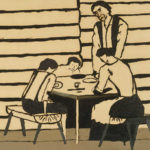We run our website the way we wished the whole internet worked: we provide high quality original content with no ads. We are funded solely by your direct support. Please consider supporting this project.

How Classical Theology Gets It Wrong
Classical theology has conceived of God as altogether necessary, simple, timeless, unchanging and unknowable. This view of God requires us to conclude that biblical images of God do not reflect the way God truly is insofar as they portray God moving in sequence with humans from the past into the future, for this obviously conflicts with God’s timelessness. Yet, no one disputes that most, if not all, biblical depictions of God portray God in just this fashion. The same holds true of biblical depictions of God being impacted by, and responding to, human activity, or of God changing his plans in light of actions that humans take. Moreover, those who espouse this classical view of God, interpret all depictions of God grieving, getting angry, being frustrated, or suffering out of love for wayward humans as failing to reflect God’s true nature.
In fact, some have gone so far as to claim that biblical depictions fail to reflect the way God truly is insofar as they simply portray the God-world relationship as something that is real to both God and the world. I challenge readers to find a biblical image of God that depicts the God-world relationship as other than real to both God and the world.
When biblical authors depict God’s relationship to the world in any of these ways, they conflict with the classical conception of God. According to classical theists, these sorts of depictions must therefore be interpreted as accommodations, anthropomorphisms, and/or as examples of Scripture speaking in terms of how God appears to us rather than in terms of how God actually is. Portraits of God with these dynamic and relational characteristics—which is true to some degree for every divine portrait in Scripture—must be judged to be falling short of the truth.
In fact, some have argued that to interpret biblical depictions of God dynamically interacting with his people as reflecting the way God truly is borders on idolatry. For example, Herbert McCabe argues that, “the God spoken of by those who insist on God’s participation in the history of his people, sharing their experiences, their sufferings and triumphs, is perilously like one of the gods” (God Matters, 42).
By disallowing the depictions of God’s sequential, dynamic, personal, mutually influential relationship with his people to reflect the way God truly is, classical theology has actually undermined the most distinctive and most distinctly beautiful dimension of the Bible’s portrait of God.
We should ground all our thinking about God, from start to finish, in the beautiful revelation of God in the crucified Christ as witnessed to in Scripture. And when we ground our reflections in this starting point, it makes all the difference in the world!
If we anchored all of our thinking in the cross, would it ever occur to us to suspect that God is altogether immutable or “above” experiencing sequences? The Word was made flesh and became our sin and our curse! If we trust this revelation, God apparently can change and God apparently does experience a “before” and “after”! Along the same lines, if our complete trust was in this supreme revelation and not in our own reasoning processes, would we ever suspect that God cannot be impacted by what transpires in the world or that God can’t suffer? If we trust that the one who hung in agony on the cross reveals God’s true nature, would we not rather conclude that God is profoundly impacted by what transpires in the world and is capable of the greatest suffering imaginable? And finally, if all our reflections about God began with the cross, I submit that the very last thing we would ever suspect is that the relationship between God and the world is real to us but not to God!
Photo credit: Josh Felise via Unsplash
Category: General
Tags: Bible, Classical Theism, Cruciform Theology, Philosophy
Topics: Attributes and Character
Related Reading

Did God Give Violent Laws? A Response to Paul Copan (#13)
In his critique of Crucifixion of the Warrior God (CWG) at the Evangelical Theological Society annual meeting in November, Paul Copan takes issue with my contention that the violent dimension of OT laws reflects God accommodating the fallen and culturally conditioned perspectives of his people at this time. In my view, God was stooping to…

Podcast: Why Must God Wait for Prayer to Meet Our Needs?
Is God a bad father? Greg explores the intricacies and nuances of prayer. http://traffic.libsyn.com/askgregboyd/Episode_0404.mp3

Cross Vision Coming Soon!
In Greg’s new book, Cross Vision, he explains how the crucifixion of Jesus makes sense of the violent portraits of God in the Old Testament. His groundbreaking “cruciform hermeneutic” will change the way that you read the Bible! While Crucifixion of the Warrior God laid out Greg’s case in detail for an academic audience, Cross Vision…

Overemphasizing Christ?
In response to my work, some have argued that I tend to overemphasize Christ. In light of the claim that in Jesus we have the one and only definitive Word of God and that no previous revelation should ever be placed alongside him or allowed to qualify what he reveals about God, some allege that…

Does God Inflict Physical Disabilities?
In Exodus 4, we find Moses claiming that he could not be used by Yahweh to get the children of Israel out of Egypt because he was “slow of speech and tongue.” To this Yahweh replies, “Who gave human beings their mouths? Who makes them deaf or mute? Who gives them sight or makes them…

Part 2: Disarming Flood’s Case Against Biblical Infallibility
Image by humancarbine via Flickr In this second part of my review of Disarming Scripture I will begin to address its strengths and weakness. [Click here for Part 1] There is a great deal in Disarming Scripture that I appreciate. Perhaps the most significant thing is that Flood fully grasps, and effectively communicates, the truth that…
